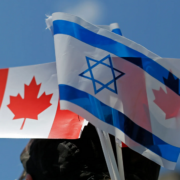Women of Valour Series celebrates Diana Goodman read by Sheila Smolkin
 On January 30th, we welcome Rosh Chodesh Shevat, a month associated with the zodiac sign of Aquarius, symbolized by the water bearer. This imagery is connected to the biblical verse, “water will flow from his wells,” which figuratively calls upon each of us to share knowledge, inspire others, and lead. The acrostic “Shenishma Besurot Tovot” translates to “We should hear good news,” reflecting that Shevat is a month of positivity and good tidings.
On January 30th, we welcome Rosh Chodesh Shevat, a month associated with the zodiac sign of Aquarius, symbolized by the water bearer. This imagery is connected to the biblical verse, “water will flow from his wells,” which figuratively calls upon each of us to share knowledge, inspire others, and lead. The acrostic “Shenishma Besurot Tovot” translates to “We should hear good news,” reflecting that Shevat is a month of positivity and good tidings.
In this spirit, we honour Diana Goodman, who served as president of our congregation from 1981 to 1983. Diana was a true trailblazer at a time when women were beginning to break barriers in boardrooms. Her leadership was instrumental in making significant inroads for women, and she continues to make a lasting impact on our community. Diana’s dedication, vision, and pioneering spirit are an inspiration to us all.
Please join us on Rosh Chodesh Shevat, January 30th, at 7:30 am during Shacharit Services as we celebrate our Past President Diana Goodman. We invite you to stay after services for Kiddush. All are welcome! Learn more & join us here: holyblossom.org/rosh-chodesh/
Breakfast following Shacharit services is generously sponsored by Joan Garson, Sheila Smolkin, and Judy Winberg, in honour of Diana Goodman.
Reflection by Sheila Smolkin
When Diana was completing her term as President of Holy Blossom Temple, the cover of a bulletin issue showed her as “Princess Di”. While this edition of the Bulletin was intended to be a Purim spoof, it nevertheless recognized that Diana had that elegance about her that she carried with her throughout her life.
Diana was born in Glasgow, Scotland and came to Canada with her parents in 1949 at the age of four. She grew up in Scarborough and joined Holy Blossom in 1968 after her marriage to her husband, Marvin, and her conversion to Judaism.
When her daughter started attending Nursery School at Temple, Diana responded to a blurb in the Bulletin from the Religious School office asking for volunteers to help with some clerical work. So while Sarah was in school, Diana would spend her mornings working with Annie Lasarge and Ruth Levine updating the school records.
Once involved with Temple life, Diana was introduced to Sisterhood (now Women of Holy Blossom), attended some of its programs and joined its Board. In particular, she remembers co-chairing the Religious School Festivals Committee with Sandy Schafer.
Moving up the ranks of the Sisterhood Board, Diana held the position of its President from 1981–83. After completing this term, she represented Holy Blossom Sisterhood on the Board of Women of Reform Judaism (then known as the National Federation of Temple Sisterhoods).
Diana continued to be involved in many aspects of Temple life, serving on several committees. She remembers getting a call from Gordy Wolfe, chair of the Temple Nominating Committee, asking her if she would be prepared to become an officer of the Temple. She accepted the invitation and served as an officer under the presidency of Fred Zemans, Richard Krelstein, and Nancy Ruth. Diana was then elected President of the congregation, a position she held from 1992-1994.
Diana continues to be an active member of the congregation. She played an important role in the Temple’s celebration of its 150th anniversary, co-chairing its opening event with Fred Zemans, an occasion many of us remember fondly. She recently returned to the Temple Board as a representative of the past presidents. She has become involved with Ve’ahavta, a Jewish Humanitarian Organization, and has spent many nights in the Ve’ahavta van giving out food and clothing supplies to those in need.
Diana can be found most Shabbat mornings in Shul attending services where the sounds of the incredible music we have can lift her spirits and provide comfort during difficult times. And, of course, she continues to be there in her unique, elegant style that is an inspiration to her friends and fellow Temple members who are fortunate to know her well.








 I am a fellow member of Holy Blossom and a passionate museum enthusiast. My love for museums inspired me to pursue a career in the field, earning a degree in Museum Studies with a focus on collections and research. This journey began with a BA in Anthropology and Art History from UBC and continued with a Master’s in Provenance Studies from the University of Glasgow. To contribute to our wonderful community, I have volunteered to assist in developing a new exhibition for the Living Museum at Holy Blossom. As part of an upcoming exhibition project for the Living Museum dedicated by George z”l and Susan Cohon and Family, we are reaching out to ask if members of our congregation would be willing to loan their Kiddush cups for display.
I am a fellow member of Holy Blossom and a passionate museum enthusiast. My love for museums inspired me to pursue a career in the field, earning a degree in Museum Studies with a focus on collections and research. This journey began with a BA in Anthropology and Art History from UBC and continued with a Master’s in Provenance Studies from the University of Glasgow. To contribute to our wonderful community, I have volunteered to assist in developing a new exhibition for the Living Museum at Holy Blossom. As part of an upcoming exhibition project for the Living Museum dedicated by George z”l and Susan Cohon and Family, we are reaching out to ask if members of our congregation would be willing to loan their Kiddush cups for display.


